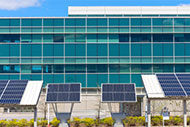An increasing number of health care organizations plan to take action to cut energy costs or are seeking green building certification for new building projects, but financial constraints make it an ongoing challenge for hospitals to achieve their energy-saving objectives.
Those are among the key findings from the 2010 Energy Efficiency Indicator (EEI) survey. The survey was conducted jointly by the American Society for Healthcare Engineering (ASHE), Johnson Controls Institute for Building Efficiency and the International Facility Management Association (IFMA).
 Survey data from the 288 health care sector respondents show that 80 percent of facility executives and managers plan either to incorporate energy-saving elements or achieve green building certification in new construction. That compares with 72 percent who said in the 2008 survey that they would take those actions.
Survey data from the 288 health care sector respondents show that 80 percent of facility executives and managers plan either to incorporate energy-saving elements or achieve green building certification in new construction. That compares with 72 percent who said in the 2008 survey that they would take those actions.
The survey also determined that 58 percent of health care building executives and managers believe that energy management is extremely or very important to their organization. In addition, 67 percent of health care organizations plan to make capital investments in energy efficiency over the next 12 months, the same percentage as in the 2008 survey.
According to the 2010 survey, 99 percent of health care respondents cited energy cost savings as extremely, very or somewhat significant factors that motivate energy-efficient investments. Enhanced brand image was cited by 72 percent of health care respondents as a significant factor for making energy-efficient investments.
"In looking at this issue over a period of time it seems that all the trends are moving in the direction that we expect them to move. We expect that energy is becoming a greater resource that people are trying to conserve, so organizations are putting more money in energy-saving projects," comments Dale Woodin, CHFM, FASHE, executive director of ASHE.
Woodin says investing in energy efficiency can help hospitals reduce their carbon footprint or earn a green label or certificate, all opportunities to enhance a hospital's image. But cutting costs is still the primary motivation, he notes.
Of the energy-saving measures taken by hospitals over the past year, the most common were switching to energy-efficiency lamps, ballasts or lighting fixtures, actions taken by 73 percent of the respondents; adjusting HVAC controls to reduce run time, 57 percent; installing occupancy or daylight sensors, 56 percent; and upgrading the building automation system, 56 percent.
Despite the priority placed on saving energy, health care organizations face serious challenges to energy investments. The survey showed that 45 percent of the respondents said that a lack of capital is the primary barrier to increasing energy-efficiency investments.
Other barriers were related to concerns about the financial returns on energy-saving investments. More than one-third of the health care respondents said that either an insufficient return on investment (ROI) or uncertainties that the projected ROI would occur are challenges to making energy-efficiency investments.
The average maximum allowable payback period for an energy-efficiency investment in the health care sector is 3.4 years, which is down from 3.8 years in 2008, the survey showed.
"In light of the difficult credit environment, it comes as no surprise that our industry is paying close attention to ROI," Woodin says.
Richard Smith, director, energy solutions, health care, Johnson Controls, says limited access to capital to invest in energy upgrades continues to hold the industry back from reaching the full savings potential of energy efficiency.
"It is important for health care decision-makers to become educated about the alternative methods that are emerging," he says.





